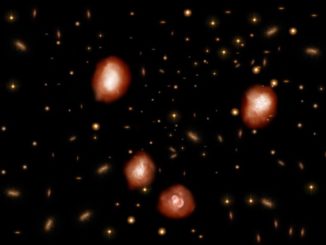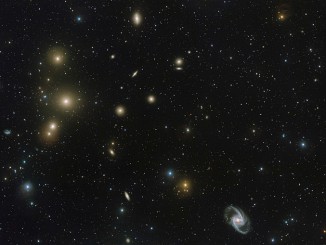
elliptical galaxies



Spiral-like patterns of star formation discovered in old galaxies
Elliptical and Lenticular galaxies (historically referred to as early-type galaxies) are thought to be no longer giving birth to new stars. Now, a team led by astronomers from the Instituto de Astrofísica e Ciências do Espaço (IA) in Portugal has discovered optical spiral features in the outskirts of three nearby early-type galaxies, which points to a still ongoing inside-out growth.

Mysterious flaring X-ray objects discovered in nearby galaxies
Astronomers have found a pair of extraordinary cosmic objects that dramatically burst in X-rays, flaring up to become about a hundred times brighter in less than a minute, before returning to original X-ray levels after about an hour. This discovery may represent a new class of explosive events found in space.

‘Frankenstein’ galaxy UGC 1382 surprises astronomers
About 250 million light-years away, there’s a neighbourhood of our universe that astronomers had considered quiet and unremarkable. But now, scientists have uncovered an enormous, bizarre galaxy possibly formed from the parts of other galaxies. Some 718,000 light-years across, UGC 1382 is more than seven times wider than the Milky Way.

Gazing into the furnace: VST captures the Fornax Cluster
This new image from the VLT Survey Telescope (VST) at ESO’s Paranal Observatory in Chile captures a spectacular concentration of galaxies known as the Fornax Cluster, which can be found in the Southern Hemisphere constellation of Fornax (The Furnace). The cluster plays host to a menagerie of galaxies of all shapes and sizes, some of which are hiding secrets.

ALMA spots monstrous baby galaxies cradled in dark matter
Astronomers using the Atacama Large Millimetre/submillimetre Array (ALMA) have discovered a nest of colossal baby galaxies 11.5 billion light-years away. The young galaxies seem to reside at the junction of gigantic filaments in a web of dark matter. These findings are important for understanding how enormous galaxies like these are formed and how they evolve into huge elliptical galaxies.

Hubble reveals galaxy gas flow and star birth regulated by black-hole jets
Astronomers have uncovered a unique process for how the universe’s largest elliptical galaxies continue making stars long after their peak years of star birth. NASA’s Hubble Space Telescope revealed brilliant knots and chains of hot, blue stars forming along the jets of active black holes found in the centres of giant elliptical galaxies.

The dark matter conspiracy
A new study finds that elliptical galaxies maintain a remarkably constant circular speed out to large distances from their centres, in the same way that spiral galaxies do. In these very different types of galaxies, stars and dark matter somehow conspire to redistribute themselves to produce this effect, or does modified Newtonian dynamics offer an explanation?
